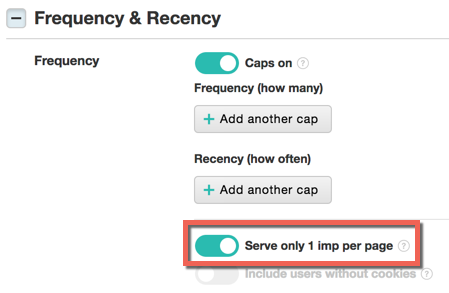Note
Access to this page requires authorization. You can try signing in or changing directories.
Access to this page requires authorization. You can try changing directories.
When you run multi-tag auctions via Microsoft Advertising's seller tag, you get the ability to set page caps. Page caps can be used to restrict advertisers, line items, campaigns, or brands from winning more than one ad slot per AST ad call.
Buy-side page caps (advertiser, line item, and campaign) can be used to exclude similar campaigns from serving with each other. However, they don't cover the use case where you only want one impression per brand to show on an AST ad call, no matter the buyer. That use case is covered by Sell-Side Page Caps.
Important
This feature is not available to clients by default. If you would like to enable this feature, please speak with your Microsoft Advertising representative.
Buy-side page caps are also enforced on OpenRTB calls.
Enable page caps for an advertiser
To set up buy-side page caps, select Advertisers > All Advertisers. Select the appropriate advertiser and click the Edit button that appears to the right of the advertiser name.
On the Edit Advertiser page, expand the Frequency & Recency section. Toggle to turn Caps On. Select Serve only 1 imp per page.
Note
Frequency and Recency options are also available at the line item, campaign, and creative level. See Frequency and Recency Caps for more information.

Important
Note that roadblocks are counted as single creatives when applying per page frequency caps.
Example buy-side scenarios
The following examples show in more detail how buy-side page caps work.
Example buy-side cap in action, enforcing correctly
Let's say you have the following setup:
- A page with a single AST ad call for two ad slots
- Two campaigns for Coca-Cola under the same advertiser, both at priority 5
- A single campaign for Nike, at priority 4
- You never want to show both Coca-Cola campaigns at the same time to one user
If you apply page caps to the Coca-Cola advertiser and run the AST ad call, the following will happen:
- Ad slot 1 goes to the first Coca-Cola campaign at priority 5
- The second Coca-Cola campaign is excluded from winning ad slot 2, so Nike wins instead
- Bids are returned to the Impbus and external bidders (if allowed) can bid
- Coca-Cola wins ad slot 1, Nike wins ad slot 2
Example buy-side cap in action, enforcing correctly, but not as expected
Let's say you have the same setup as described above. If you apply page caps to the Coca-Cola advertiser and run the AST ad call, the following could happen:
- The two Coca-Cola campaigns and the single Nike campaign are returned to the Impbus for decisioning
- External bidder comes in and bids $10 CPM for a Coca-Cola ad in ad slot 2
- If the $10 CPM bid has a higher expected network revenue than the Nike bid, then it will win
- Ad slots return to the page, user sees Coca-Cola ads in both slots
To avoid this outcome, we recommend enabling Sell-Side Page Caps.